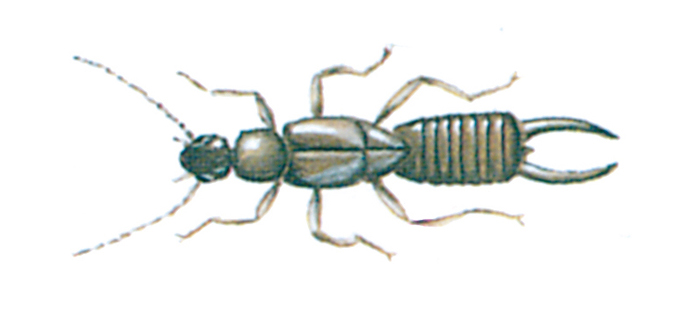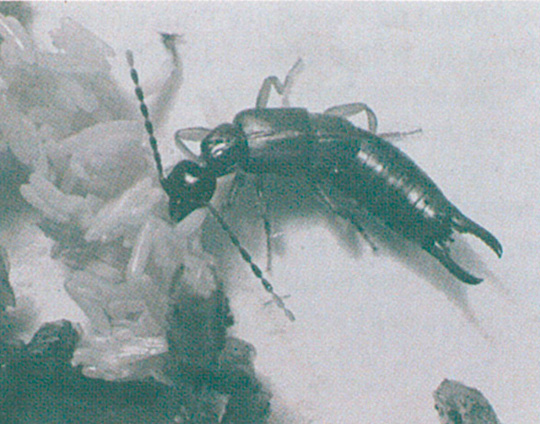(Latin: Forficula auricularia)

Earwigs start to come into houses in late summer, seeking good hiding-places, for they are nocturnal animals which spend the day in sheltered places. These they find in abundance in the human environment, in the cracks and crevices of doors and windows, folded handkerchiefs, bath towels and so on.
By mid-September, however, they have mostly buried themselves in the ground where they spend the winter.
Earwigs mate in the autumn and the male and female often spend the winter together until early spring when the male is driven out. The female then prepares a brood chamber in the ground and lays 50 eggs in it.
The female earwig is very faithful and remains with her eggs, something which is very unusual in the insect world. She defends them valiantly against enemies, and keeps them clean. Without her care and attention they would be attacked by moulds and would soon die.

Even after the eggs have hatched the family remains together, but gradually the young move further and further away from the nest in their search for food: They become sexually mature during the course of the summer.
The common earwig is almost omnivorous, eating dead vegetable matter, live plants and carrion, and also catching small insects and mites. Earwigs may cause damage in gardens and nurseries for they gnaw plants. On the other hand, they destroy many other plant pests, such as aphids.
Many people find earwigs repulsive, and one would need to delve into their subconscious to understand why. They have, of course, always played a part in folklore and in practically all European countries their popular name refers to their predilection for ears. ‘The sweet innocence’, says an earwig mother in one of Hans Christian Andersen’s stories about her son, ‘His greatest ambition is to be able to creep into the ear of a priest. He is so touchingly childish, it gladdens a mother’s heart’. The really gruesome stories tell how earwigs cut their way through the eardrum and lay their eggs in the brain. This is, of course, absolute nonsense, although it is true that an earwig may occasionally creep into an ear, as into any other dark corner.
The terminal forceps are used both for attack and defence, but mostly as a deterrent. Earwigs only nip humans when squeezed, as for example when one rolls over on them in bed. They may leave a tiny bruise, but the skin is not punctured.
The best method of avoiding a plague of earwigs is to deny them suitable living conditions close to the house. Luxuriant plant growth and compost heaps provide excellent quarters for them. The nuisance can be ameliorated by catching them in traps. Simply fill a flowerpot with peat or plant fibre and stand it with the bottom up. The earwigs will creep into the trap which can be emptied every morning.




